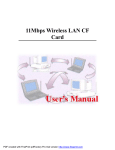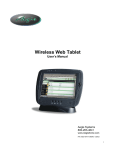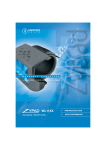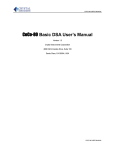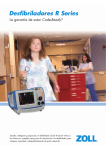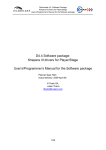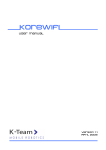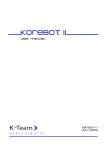Download AmbiCom WL1100B-AP User manual
Transcript
AmbiCom WL1100B-CF / WL1100C-CF Wireless LAN Compact Flash Adapter User Manual Version 2.00 March 29, 2002 Federal Communications Commission Statement This device complies with FCC Rules Part 15. Operation is subject to the following two conditions: This device may not cause harmful interference. This device must accept any interference received, including interference that may cause undesired operation. This equipment has been tested and found to comply with the limits for a Class B digital device, pursuant to Part 15 of the FCC Rules. These limits are designed to provide reasonable protection against harmful interference in a residential installation. This equipment generates, uses and can radiate radio frequency energy. If this equipment is not installed and used in accordance with the manufacturer's instructions, it may cause harmful interference to radio communications. However, there is no guarantee that interference will not occur in a particular installation. If this equipment does cause harmful interference to radio or television reception, which can be determined by during the equipment off and on, the user is encouraged to try to correct the interference by one or more of the following measures: Reorient or relocate the receiving antenna. Increase the separation between the equipment and receiver. Connect the equipment to an outlet on a circuit different from that to which the receiver is connected. Consult the dealer or an experienced radio/TV technician for help. The use of shielded cables for connection of the monitor to the graphics card is required to assure compliance with FCC regulations. Changes or modifications to this unit not expressly approved by the party responsible for compliance could void the user's authority to operate this equipment. Manufacturer's Disclaimer Statement The information in this document is subject to change without notice and does not represent a commitment on the part of the vendor. No warranty or representation, either expressed or implied, is made with respect to the quality, accuracy or fitness for any particular purpose of this document. The manufacturer reserves the right to make changes to the content of this document and/or the products associated with it at any time without obligation to notify any person or organization of such changes. In no event will the manufacturer be liable for direct, indirect, special, incidental or consequential damages arising out of the use or inability to use this product or documentation, even if advised of the possibility of such damages. This document contains materials protected by copyright. All rights are reserved. No part of this manual may be reproduced or transmitted in any form, by any means or for any purpose without expressed written consent of its authors. Product names appearing in this document are mentioned for identification purchases only. All trademarks, product names or brand names appearing in this document are registered property of their respective owners. Table of Contents Chapter 1 Introduction...................................................................................... 1 1-1 Features and Benefits ................................................................................ 1 1-2 Applications............................................................................................... 2 1-3 Product Kit ................................................................................................ 3 1-4 System Requirements ................................................................................. 3 Chapter 2 Installing Wireless Compact Flash Adapter ...................................... 4 2-1 Install the Setup Utility .............................................................................. 4 2-2 Install WL1100X-CF Wireless LAN Compact Flash Adapter ..................... 6 3-1 Configure your WL1100X-CF with Wireless LAN Configuration Utility .... 8 Caveat ................................................................................................................ 17 Appendix A Network Configuration ........................................................................... 18 A-1 Network Topology ................................................................................... 18 Chapter 1 Introduction The AmbiCom WL1100X-CF (including WL1100B-CF and WL1100C-CF) Wireless LAN Compact Flash Adapter is a standard CF interface adapter integrated with wireless LAN technology. It provides you the easiest, fastest, way to access your wireless and wired network. The Wireless Compact Flash Adapter, which utilizes the latest advancement of PC industry – Compact Flash technology, allows you to install and use the card reader easier than ever before. 11Mbps data rate gives equivalent Ethernet speed to access corporate network or the Internet in a wireless environment. When installed, 11Mbps Wireless LAN Compact Flash Adapter is able to communicate with any 802.11 and 802.11b compliant products. 1-1 Features and Benefits 1. Supports 1, 2, 5.5 and 11 Mbps data rate. 2. Working range up to 800 ft. in an open environment. 3. Supports point-to-point and point-to-multipoint access. 4. Seamless connectivity to wired Ethernet and PC network LAN’s augments existing networks quickly and easily. 5. Direct Sequence Spread Spectrum (DSSS) technology provides robust, interference-resistant and secure wireless connection. 6. Wireless connection without the cost of cabling. 7. Supports CE 2.x/3.0 Handheld/Pocket PC. 8. Support high security WEP encryption (64-bit and 128-bit) 9. Supports Plug and Play. 10. Easy installation. -1- 1-2 Applications AmbiCom Wireless LAN products offers a fast, reliable, cost-effective solution for wireless client access to the network in applications like these: 1. Remote access to corporate network information E-mail, file transfer and terminal emulation. 2. Difficult-to-wire environments Historical or old buildings, asbestos installations, and open area where wiring is difficult to deploy. 3. Frequently changing environments Retailers, manufacturers and those who frequently rearrange the workplace and change location. 4. Temporary LANs for special projects or peak time Trade shows, exhibitions and construction sites where a temporary network will be practical. Retailers, airline and shipping companies need additional workstations during peak period. Such as auditors requiring workgroups at customer sites. 5. Access to database for mobile workers Doctors, nurses, retailers, accessing their database while being mobile in the hospital, retail store or office campus. 6. SOHO (Small Office and Home Office) users SOHO users need easy and quick installation of a small computer network. 7. High security connection The secure wireless network can be installed quickly and provide flexibility. (Please refer to page 11 for encryption configuration.) -2- 1-3 Product Kit AmbiCom Wireless LAN Compact Flash Adapter comes with the following items. Please go through each item below. If any listed item is not included or found damaged, please contact your local dealer. 11Mbps Wireless LAN Compact Flash Kit Includes: l l WL1100X-CF Wireless LAN Compact Flash……..…….………………………… x 1 Software and Documentation CD or Floppy Diskette……..………………………. x 1 l WL1100X-CF Wireless LAN Compact Flash Quick Start Guide…………………. x 1 1-4 System Requirements The WL1100X-CF Wireless LAN Compact Flash Adapter has been tested and supports the following Handheld/Pocket PCs: n n n Compaq: HP: Casio: iPaq (Strong ARM), Aero Jonada 565 and 720 E125 (MIPS R4000), BE-300, BE-500 Please check with AmbiCom’s website at http://www.ambicom.com for further information. -3- Chapter 2 Installing Wireless Compact Flash Adapter This chapter describes the installation of the 11Mbps Wireless LAN Compact Flash driver for the CE 2.x/3.0 Handheld/Pocket PC. 2-1 Install the Setup Utility 1. Establish a connection between host PC and PDA device by Microsoft Active Sync. 2. Insert AmbiCom WL1100X Installation CD and click on Install “Wave2Net Products”. Following menu selection will show up, click on “Install WL1100X-CF for WinCE”. 3. Setup file will start automatically. 4. An InstallShield Wizard window appears. Click Next to proceed. -4- 5. Follow on-screen instructions to install the Setup Utility. Click Finish to complete the installation. Restart your PDA. -5- 2-2 Install WL1100X-CF Wireless LAN Compact Flash Adapter 1. Connect the AmbiCom Wireless LAN Compact Flash Adapter to your PDA. The PDA will auto-detect the WL1100X-CF Compact Flash Adapter and bring up the configuration utility. 2. Check IP settings of your Wireless LAN Compact Flash Adapter. You may either set the Wireless LAN Compact Flash Adapter to obtain an IP address from your DHCP server, or to be assigned with a fixed IP address. Click on “IP Status” button to check your current IP settings. -6- 3. Upon completion of installation, the Wireless LAN Compact Flash Adapter will start to look for an Access Point with Green LED blinking. The Green LED will stay steady once the Wireless LAN Compact Flash Adapter successfully associates with an Access Point. To configure the Wireless LAN Compact Flash Adapter please proceed to the next chapter “ Using WL1100X-CF Wireless LAN Compact Flash Adapter”. -7- 3 Using WL1100X-CF Wireless LAN Compact Flash Adapter This chapter gives you assistance with detailed description of setting the AmbiCom WL1100X-CF Wireless LAN Compact Flash Adapter with the Wireless LAN Configuration Utility under Pocket/Handheld PC. 3-1 Configure your WL1100X-CF with Wireless LAN Configuration Utility The AmbiCom WL1100X-CF Wireless LAN Compact Flash Adapter is a ready-to-use device. Its default settings perform for a typical Infrastructure Wireless LAN. Simply plug in the Wireless LAN Compact Flash Adapter onto your computer and it is ready to use. In special situations however, you may adjust configuration settings depending on how you would like to manage your wireless network. The Wireless LAN Utility provides you an easy interface to make configuration changes and perform user-level diagnostics on your Wireless LAN Compact Flash Adapter. 1. Once plug in the WL1100X-CF adapter, Configuration utility will be automatically invoked. Following Configuration window will appear: -8- 2. Or on some older WinCE system, if the Configuration Utility did not show up, user can go to Program group and click the “WL1100” icon. The above Configuration Utility windows will be brought up. 3. When the Configuration Utility window appears, it will provides following selection items for you to configure and monitor the WL1100X-CF Wireless LAN Compact Flash Adapter. -9- Status The Status tab displays the current status of the WL1100X-CF Wireless LAN Compact Flash Adapter. Connected to - Displays the Access Point the WL1100X-CF Wireless LAN Compact Flash Adapter associates with. AP MAC Addr - Shows MAC Address of the Access Point that the WL1100X-CF Wireless LAN Compact Flash Adapter associates with. Mode - Displays the current network mode settings, can be Infrastructure or Ad-Hoc modes. Channel - Displays the current channel that the Wireless Compact Flash is using. Link Rate - Displays the current link connection speed. Encryption - Displays the current WEP setting. IP Status – This button will displays the current IP settings and DHCP status. -10- Configuration The Configuration tab contains several fields where the current parameters of the Wireless LAN Compact Flash Adapter can be viewed and changed. You will see current configuration information in terms of Network Mode, Network SSID, Link Rate and Channel number (in Ad-Hoc mode). Upon modification of parameters for the Wireless LAN Compact Flash Adapter, click the Connect button to make the changes take effect. -11- Network Mode To connect your wireless station to a local network infrastructure as described in Appendix A “ Network Configuration” on page 16, set the station operation mode to Infrastructure (with Access Point, default setting). In case you do not wish to connect to a network infrastructure, but prefer to setup a small wireless workgroup, you can enable the Ad-Hoc or 802.11 Ad-Hoc modes. When the Ad-Hoc mode is selected, be sure to set your wireless stations with the same channel. To use the 802.11 Ad-Hoc mode, the same channel and SSID among wireless stations are acquired. Network SSID The Network SSID is a unique ID given to the Access Point. Wireless clients associating to Access Points must have the same Network SSID. The default value ANY means when the WL1100X-CF Wireless LAN Compact Flash Adapter starts to work, it will associate with the Access Point that gives the fastest response. You may also enter a specific Network SSID (Access Point) you desire to connect with. It is recommended you specify an SSID for your Wireless LAN Compact Flash Adapter. This will prevent your computer from unintentionally connecting to a different wireless network. The most convenient feature of AmbiCom WL1100X-CF Configuration Utility is the real-time Access Point scanning function. If you click on the dropdown button, current available Access Points will display and user can select from the list without typing any single character. Link Rate The WL1100X-CF Wireless LAN Compact Flash Adapter provides various data rate options for you to select. Data rates options include Auto, Fixed 1Mb/s, Fixed 2Mb/s, Fixed 5.5Mb/s, and Fixed 11Mb/s. In most networking scenarios, you will see that the factory-set default “Auto” -12- will prove the most efficient. This setting will allow your WL1100X-CF Wireless LAN Compact Flash Adapter to operate at the maximum data rate. When the communications quality drops below a certain level, the Wireless LAN Compact Flash Adapter will automatically switch to a lower data rate. Transmission at lower data speeds is usually more reliable. However, when the communications quality improves again, the Wireless LAN Compact Flash Adapter will gradually increase the data rate again, until it has reached the highest available transmit rate. IP Config – This button will displays a dialog box for you to change your IP address settings. Performance Performance will display total bytes been transmitted and received statistically. Also it provides the current wireless signal information for user to better realize their wireless connection. Link Quality - Link quality monitors the quality of the data transmission between the Wireless Compact Flash Adapter and an Access Point. Signal Level - This bar graph displays signal strength as reported by the radio, averaged over all frames that are received from the Access Point. -13- Site Monitor AmbiCom WL1100X-CF Configuration Utility provides “Site Monitor” feature for users to find out surrounding Access Points and 802.11 Ad-Hoc networks available. Site survey results such as Signal strength, MAC address and other useful information will bring users comprehensive wireless site overview. -14- Advanced To prevent unauthorized wireless stations from accessing data transmitted over the network, the WL1100X-CF Wireless LAN Compact Flash Adapter offers highly secure data encryption, known as WEP (Wired Equivalent Privacy). If you desire to use WEP encryption, please select the 40 bit WEP or 128 bit check box and set the following values. There are three types of WEP encryption described as follows: None – There won’t be data encryption in wireless communication. 40 Bit – Requires wireless stations to use data encryption with 40-Bit WEP (64-bit encryption) when communicating with the Access Point. 128 Bit – Allows wireless clients to communicate with the Access Point with 128-Bit encryption. The tab enables you to identify up to 4 different encryption keys and select one of them to encrypt your transmission data. The key value of your choice may either be: For 40-bit encryption: n 10 digit hexadecimal values in the range of “A-F”, “a-f” and “0-9” in 5 entry boxes (e.g. 11 AA 22 BB 33). For 128-bit encryption: n 26 digit hexadecimal values in the range of “A-F”, “a-f” and “0-9”, in 13 entry boxes (e.g. 11 AA 22 BB 33 12 34 56 78 9A BC DE FF). -15- Packet Fragmentation – When the packet size is larger than the number, packet will be split into fragmentations before transmission. Power Management –When Power Management is enabled, WL1100X-CF Wireless LAN Compact Flash Adapter will go into Power Management mode to minimize power consumption. NOTE: When Power Management is enabled, the Access Points you use need to support Power Management as well so that the communication can be established. RTS/CTS Medium Access – Turn on only if Access Points support it. About The About tab shows firmware, driver and utility version of the WL1100X-CF Adapter. -16- Caveat n Due to WinCE's nature of the first application at power-on resuming to that at power-off, if you are stuck at the utility program, you may use the PDA's reset bottom to terminate it. And activate it again when needed. n If your wireless connection to AP might disconnect, you can reset and force a connection request by going to utility program, then select "Configuration", check parameters, then select "Connect" to force a re-scan. n If your device roams to a new AP which is in a different subnet, you may need to remove and re-insert the Wireless LAN Compact Flash Adapter to force an execution of "release and renew" of an re-assignment of IP address in a DHCP Access Point environment. -17- Appendix A Network Configuration The AmbiCom WL1100X Wireless LAN products support the same network configuration options of the legacy Ethernet LANs as defined by IEEE 802 standard committee. The AmbiCom WL1100X Wireless LAN products can be configured as: u Ad-Hoc for departmental or SOHO LANs u Infrastructure for enterprise LANs u LAN-Interconnection for point-to-point link as a campus backbone. A-1 Network Topology u Ad-Hoc Fig An Example of Ad-Hoc Wireless LAN An Ad-Hoc wireless LAN is a group of computers, each equipped with one wireless adapter, connected as an independent wireless LAN. Computers in a specific Ad-Hoc wireless LAN must be configured at the same radio channel. Ad-Hoc wireless LAN is applicable at a departmental scale for a branch or SOHO operation. -18- u Infrastructure Fig An Example of Infrastructure Wireless LAN The AmbiCom WL1100X Wireless LAN devices provide access to a wired LAN for wireless workstations. An integrated wireless and wired LAN is called an Infrastructure configuration. A group of wireless LAN PC users and an Access Point construct a Basic Service Set (BSS). Each wireless-equipped PC in this BSS can talk to any computer in the wired LAN infrastructure via the Access Point. Infrastructure configuration will extend the accessibility of a wireless station to the wired LAN. Multiple Access Points will allow roaming and it will increase the transmission range. The Access Point is also able to forward data within its BSS. The effective transmission range in an infrastructure LAN is doubled. -19- Fig The effective Transmission Range -20-























